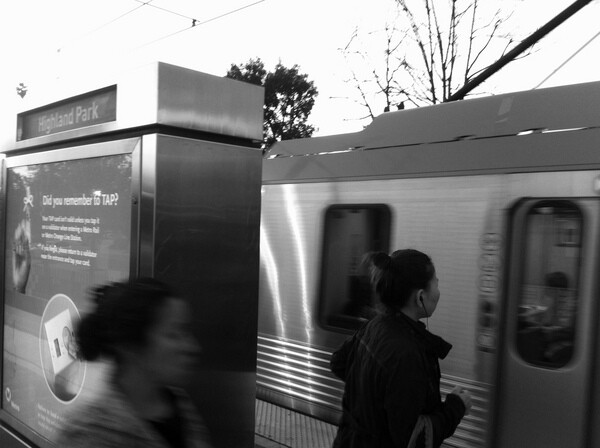A Los Angeles Primer: Highland Park

People disagree about what most meaningfully indicates whether a Los Angeles neighborhood has turned "cool." A seemingly disproportionate number of respected musical acts having emerged from it makes for one early sign. A sudden abundance of galleries and drinking spots there provides further, more solid evidence, amid which a few parking spots may stay open in the evening. Crime, for the most part, moves elsewhere. Its rents will, of course, rise — a force that inevitably renders the place uncool again. Somewhere during this process, the press naturally gets around to covering the neighborhood, and in the pre-internet era we would have said that heralded the beginning of the end; move into a part of town of which the newspapers have already made a big deal, and you've come too late.
Not quite so today, when every development, no matter how inconsequential, sends off a ripple of online coverage. My own suspicion that I'd do well to give a neighborhood further consideration emerges when it begins to produce lists, the kind that compile its "Eight Least-Known Concert Venues," say, or its "Twelve Essential Cocktails," its "Top Fifteen Highly Artisanal Coffee Experiences," its "Five Most Authentic Pupuserías." The growing prevalence of this form, long a mainstay of such bastions of journalistic rigor as Cosmopolitan magazine, doesn't seem to everyone an entirely positive phenomenon, and most lists do little to hide their sole intention of milking a few clicks from office workers bored halfway to nihilism. Still, used as a delivery system for basic information about what you'll find where, they may come in handy indeed. As Highland Park figured into more and more of them, I sensed that its moment had come.

Up in the city's northeast, past Chinatown, overlooked by Mount Washington, and nearly all the way to Pasadena, Highland Park recently spent decades off many an Angeleno's psychological map. On its streets you can still experience firsthand the elements of both that low-profile era and of the new, increasingly fashionable one. And by "streets," I mean two in particular: the long commercial stretches of York Boulevard and Figueroa Street, near whose intersection most maps place the words "Highland Park." Together they form a four-mile V shape of a surprisingly unwieldy length. For quite some time, even into its currently reported renaissance, Highland Park made little appearance on my own psychological map of the city, except as a Gold Line train station, at which I rarely disembarked. That only one stop bears its name fooled me into imagining it as a small neighborhood, when in fact it covers an unexpectedly large amount of ground.
As general interest in Highland Park has risen to match its footprint on the map, those coming for the little-known concert venues, the essential cocktails, the artisanal coffee experiences, and even the authentic pupuserías, may find them among the sorts of places originally established to take advantage of an abundance of relatively cheap property. Hence the background environment of telltale auto part shops, dollar stores, and more or less venerable detached houses, the last of which has brought in a wave of the real estate minded as well. In this sort of area the commercial and the residential can mix in unusual ways, with tax preparers' offices and martial arts studios looking barely converted from the homes as which they clearly once functioned.

But as in the yin and yang, a piece of the newer Highland Park exists in the older one, and vice versa. Take a seat outside with your pour-over, and you may gaze upon both a series of well-known cartoon characters, painted with no regard for intellectual property on the concrete wall of a discount shop, and the comparatively new comic book store just down the road — a cache of bold visual interest on several levels. If you then go in search of a donut, you can find a gluten-free ones with well-integrated bacon or, walking a little farther to pay quite a bit less, a whole rack of fluorescently-lit standards, proud in their strangely satisfying mediocrity. From this mixture, Los Angeles neighborhoods tend to generate not just fascination but a kind of strength.
Of all the businesses established in pre-coolness Highland Park, I hear few brought up more often than Galco's Soda Pop Stop on York, a veritable warehouse of carbonated drinks and candy you might have assumed either steadfastly unavailable in this part of the country, or long since discontinued. The appeal of quaintly obscure beverages and chocolate snacks hardly escapes the types who've come to Highland Park in search of vintage clothing, midcentury artifacts, real or reconstructed, and rare vinyl records. The most actively antiquarian among them would place no small value on Figueroa's U.S Office Machine Company, which has been repairing and restoring typewriters for over half a century. Too few such specialists have stuck it out to put together much of a list of them — "The Ten Most Robust Ribbon Stocks in Los Angeles"? — but the greater quality of past and present palpably coexisting, as they for the moment do in Highland Park, strikes me as meriting a list of its own. "Los Angeles' Top Urban Palimpsests," perhaps.
Photos by Colin Marshall.